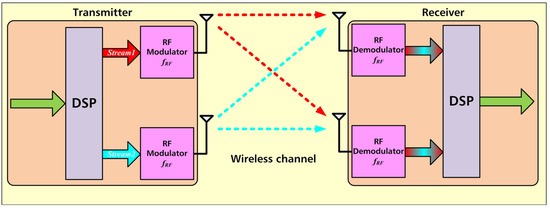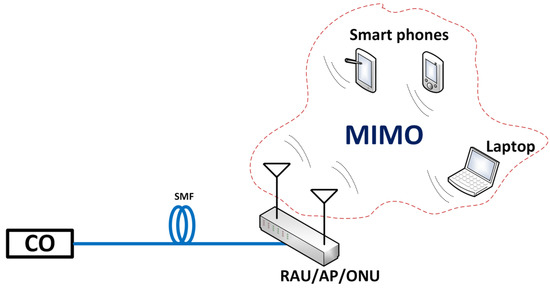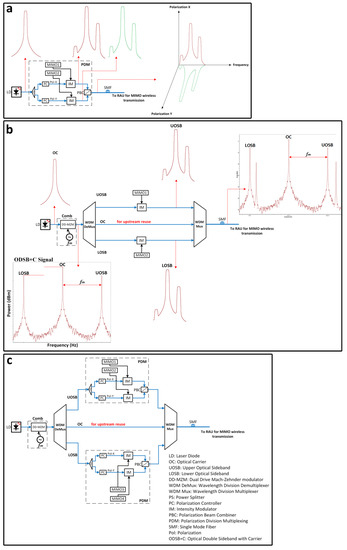This entry presents a comprehensive, contemporary review of the latest subsystems, architectures and integrated technologies of MIMO wireless signals backhauling using optical fibre or fibre access networks, such as passive optical networks (PONs).
- MIMO Wireless Signals
- fibre wireless access network
- multiple-input multiple-output
- passive optical network
Next-generation access/mobile networks have set high standards in terms of providing wireless services at high data rates in order to keep up with the vast demands for other mobility and multiple services. Wireless-optical broadband access network (WOBAN) technology, also known as fibre-wireless (FiWi), has uncovered incredible opportunities for the future of next-generation networks because it gets the best of both domains: huge bandwidth provided by the optical fibre and high ubiquity of the wireless domain. The objective of FiWi networks is to integrate the high data rate and long reach provided by optical networks and the ubiquity and mobility of wireless networks, with the target to decrease their expense and complexity. Multiple-input–multiple-output (MIMO) is an inevitable technique for most of the new mobile/wireless networks that are driven by the huge data rates required by today’s users. Consequently, to construct any FiWi system for next-generation (NG) access/broadband networks, a MIMO technique has to be considered. This article presents a comprehensive, contemporary review of the latest subsystems, architectures and integrated technologies of MIMO wireless signals backhauling using optical fibre or fibre access networks, such as passive optical networks (PONs). An overview for FiWi, PONs and MIMO wireless systems is provided. In addition, advanced techniques of accommodating the MIMO wireless signals over optical fibre are explained and compared. Different types of wireless MIMO signals over fibre, such as 5G, WiFi and related transport technologies, are reviewed. Moreover, future research trends are also discussed.
1. Introdcution
With the increasing number of smartphones and their broadband demanded applications [1], there is a huge need for high bandwidth broadband infrastructure. Moreover, the rapidly growing demands on bandwidth and end users’ new data rates consuming applications such as YouTube, Netflix, peer-to-peer downloading and cloud computing, call for the combination of the fibre and wireless domains in a unified infrastructure. FiWi networks merge wireless networks with optical networks. The wireless networks have the availability, flexibility and coverage, while optical networks support transmission speeds and overcome distance limitations [2]. FiWi systems have started to draw in broad research enthusiasm as they offer great potential for tackling the issues of high-speed Internet access “over the last mile”. Specifically, FiWi systems with a passive optical network (PON) as the optical system have been seriously concentrated in the previous years as a PON can give high
transmission bit rates for today’s bandwidth killing applications [2]. One of the best schemes to deliver the wireless signals over optical fibre is radio-over-fibre (RoF) [3]. The RoF technique has shown a promising solution for the future of mobile and access networks because of its seamless integration of the large capacity provided by the optical fibre and the flexibility, mobility and freedom of radio systems [4] and, as such, RoF has become an appealing answer for the high data rate demands and overall cost reduction of wireless systems [5]. MIMO is a foreseeable technique for most of the new mobile/wireless networks that are driven by the huge data rate required by today’s users [6]. The MIMO technique is intended to enhance transmission distance, data rate and reliability compared to the performance offered by a single-input single-output (SISO) system [7,8]. Consequently, in order to build any FiWi system to provide wireless connectivity for next generation (NG) broadband networks, the MIMO technique has to be considered [9]. In this paper, we present a comprehensive, contemporary review of the latest subsystems, architectures and integrated technologies of MIMO wireless signals backhauling using optical fibre or fibre access networks, such as passive optical networks (PONs). Sections 2–4 introduce PONs, FiWi and MIMO wireless systems, respectively, with the basic technologies and concepts enabling these systems and networks. Section 5 addresses more specific topics in wireless MIMO signals over fibre techniques. Section 6 focuses on more specific technologies for the transport of different types of wireless MIMO signals over fibre. Integrated technologies and backhauling of MIMO wireless signals over PONs are reviewed in Section 7, Section 8, suggests future work and, finally, the conclusion is
presented in Section 9.
2. Introduction to MIMO Wireless Systems
MIMO technology has been exploited and considered as the finest way to solve the bottleneck of traffic capacity in future wireless networks [34]. Moreover, MIMO constitutes a breakthrough in the design of wireless communication systems, and is already at the core of many existing and emerging wireless standards [35]. MIMO transmission is very significant in 4G and future 5G/6G networks, as it raises the capacity for end users [36].
The MIMO system enhances the traditional SISO system by many factors, such as improved transmission range, reliability and delivery of higher data rate [7]. Figure 6 shows the MIMO wireless communication system and how this system works. The MIMO technique takes advantage of a multipath wireless channel to enhance data rate, range and reduce the interference [37]. Therefore, the MIMO system can use multiple MTx transmit antennas at the transmitter side to propagate multiple parallel wireless signals along the wireless channel to multiple MRx receive antennas at the receiver side. The MIMO system usually is distinguished by an
MIMO system, such as the
MIMO system in Figure 6. There are two types of multiple antenna techniques: spatial multiplexing technique and diversity technique [38].

3. Wireless MIMO Signals over Fibre Techniques
This section addresses the challenges of manipulating different MIMO wireless signals with the same carrier frequency to fit in the same optical wavelength. The main problem in sending MIMO signals that have similar carrier frequency over a single optical wavelength directly is that they overlap in the frequency domain. There are several solutions that are proposed to solve this problem, which are discussed and compared in this section. On the other hand, in the case of sending the MIMO wireless signals in different wavelengths, there is the challenge of how to make good utilisation of the unlimited wavelength capacity and not waste it on a single MIMO stream. This challenge is also addressed by many researchers, which are discussed here. In addition, the techniques of sending MIMO signals as BBoF and its advantages and disadvantages are also presented in this section. In the next section (Section 6), the focus will be on sending different types of MIMO wireless signals over fibre.
Figure 7 shows the concept of sending MIMO signals over fibre. Depending on the configuration type, we can define the user interface with the MIMO transmission unit as AP/RAU or ONU. If the transmitted MIMO wireless signals are sent as BBoF, we can call the MIMO transmission unit an ONU. When the transmitted MIMO wireless signals are sent as RoF we can call the MIMO transmission unit RAU or AP.

Figure 7. Wireless MIMO signals over a simple fibre system.
Sending the MIMO wireless signals as BBoF is a very simple scheme for transmitting MIMO signals over fibre, as proposed in [39]. However, it is not cost-effective, since the ONU has to be associated with a wireless modem to transfer the baseband signal to its final MIMO wireless format before the wireless transmission. Therefore, it is more appealing and less expensive to deploy RoF for the transmission of MIMO wireless signals over fibre [40,41,42,43,44,45]. Moreover, analogue signal transmission leads to simpler RAUs and the analogue signals generally obtain less bandwidth than their baseband equivalents [43]. Moreover, all the advantages of the RoF scheme will be gained, such as simple configuration and no frequency up-conversion is needed at the RAU.
In the case of sending the MIMO wireless signals (spatial multiplexed) over fibre as RoF signals, the main problem in sending MIMO signals that have similar carrier frequency over a single optical wavelength directly is that they overlap in the frequency domain. There are several solutions that are proposed to solve this problem, such as using WDM [42,46]. However, it adds more cost, since, for each MIMO wireless signal, an optical source and photodetector is mandatory.
In [42], a
MIMO-RoF system is proposed for NG wireless-communication systems. To handle the MIMO signals over a single optical fibre, nine-channel coarse wavelength-division-multiplexed (CWDM) optical channels are utilised: one for link delay measurement and signal transmission control, four for downlink, and the others for uplink. This means that each MIMO stream needs a separate wavelength widely separated from the adjacent wavelength since CWDM is used. This will limit the number of users, especially if the system is used in a PON environment. The same drawback (cost) is associated with subcarrier multiplexing (SCM), in addition to its low data rate [47]. Transmission of multiple wireless MIMO signals over an optical fibre is proposed and explained using an electrical single sideband frequency-translation (ESSB-FT) technique [48]. In this approach, local oscillators at the transmitting and receiving ends are required, which is a drawback. In [49], transmission of two wireless MIMO signals with similar carrier frequency over fibre using an optical single sideband frequency-translation (OSSB-FT) technique has been proposed and demonstrated. The major disadvantage of this approach is using one wavelength for each sent MIMO stream. This consumes the optical spectrum domain, which limits the total number of users. For example, in the case of
MIMO, each RAU will need four wavelengths. In [40,50], polarisation division multiplexing (PDM) is implemented to carry each MIMO stream at a different polarisation of similar wavelength taking advantage of the wavelength’s two polarisations, as shown in Figure 8a. However, this method limits the number of MIMO streams per wavelength to only two. Among these methods, the most used and proven to be successful are: PDM [6,40,50,51,52,53,54,55,56,57,58,59,60], using comb techniques to generate multiple wavelengths [49,61,62,63,64] and also hybrid method between them as shown in Figure 8c [6]. It takes benefit from the optical frequency comb techniques and high bandwidth optical modulators (up to 100 GHz) as shown in Figure 8b [64,65,66,67], and multiple widely separated wavelengths can be produced from one continuous-wave (CW) laser. Figure 8 illustrates these three methods of transmission of wireless MIMO signals over fibre.

Figure 8. Three wireless MIMO signals over fibre transmission techniques: (a) PDM, (b) comb, (c) hybrid.
Sending MIMO signals with different frequencies (MIMO diversity technique) over fibre as RoF is easy since there is no overlap in the frequency domain. However, sending MIMO signals with the same frequency (MIMO spatial technique) over fibre as RoF is not straightforward. The problem with sending MIMO signals that have similar frequency over a single optical wavelength directly is that they overlap in the frequency domain. A diversity technique can be implemented with a stable antenna transmission technique, such as space diversity [68,69] as explained earlier. Also, the diversity technique can be implemented optically by using optical delay before the wireless transmission. For example, in [62], one of the optical signals was delayed using an additional 6 km single-mode fibre to be de-correlated with the other. In [70], the two techniques have been extensively compared for MIMO-RoF systems and it was found that, in a wireless or optical channel, the technique of spatial multiplexing is less reliable in terms of BER, which means doubling the data rate using spatial multiplexed MIMO-RoF signals will come with a cost of increasing the BER and high reception power will also be required to perform, compared with the diversity technique [70]. In can be considered that, in future implementation, a hybrid technique will be used to realise the advantages of the two techniques in the same MIMO-RoF system. In such case, the reception of the signal and separation will be a challenge in the digital signal processing (DSP) domain since it has been degraded during the optical and wireless transmission.
Table 1 summarises some of the previously proposed approaches to handle wireless MIMO signals over fibre and their disadvantages and advantages.
Table 1. Wireless MIMO signals over fibre schemes
